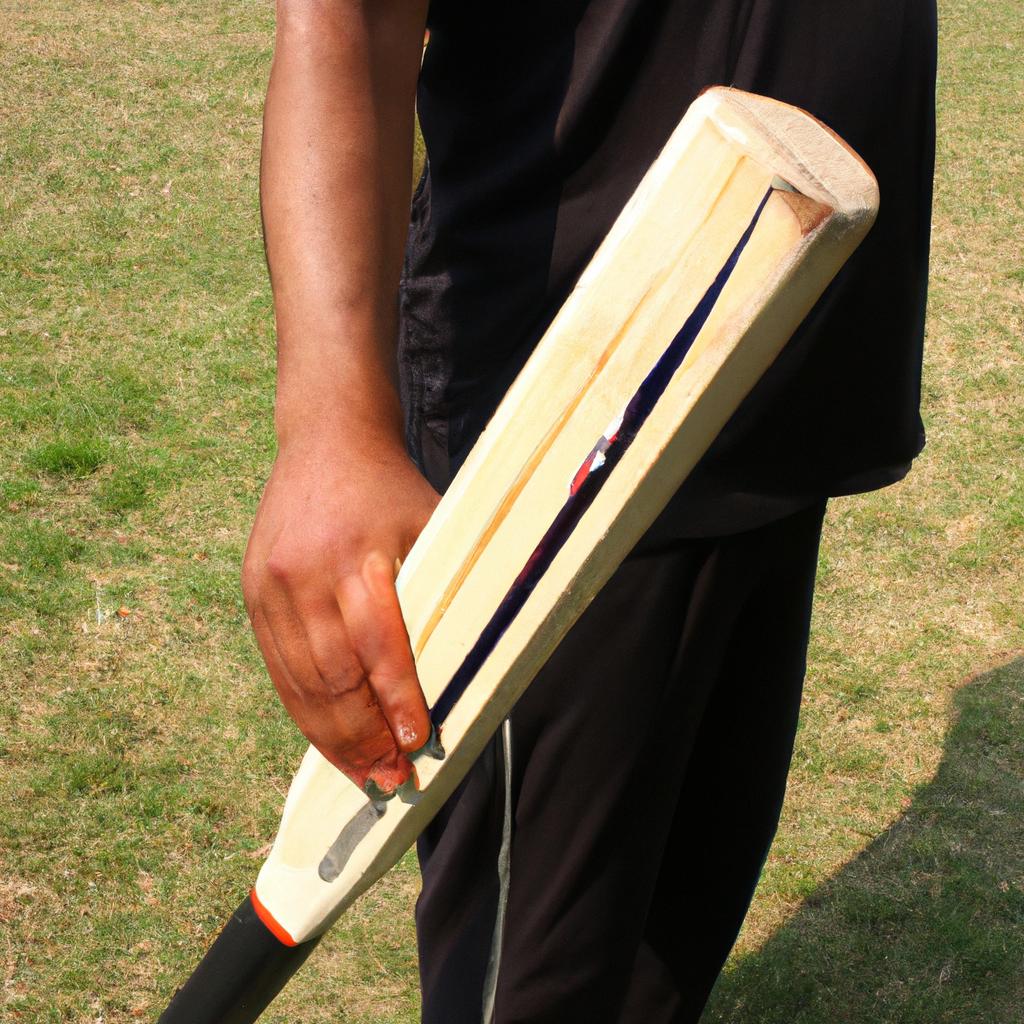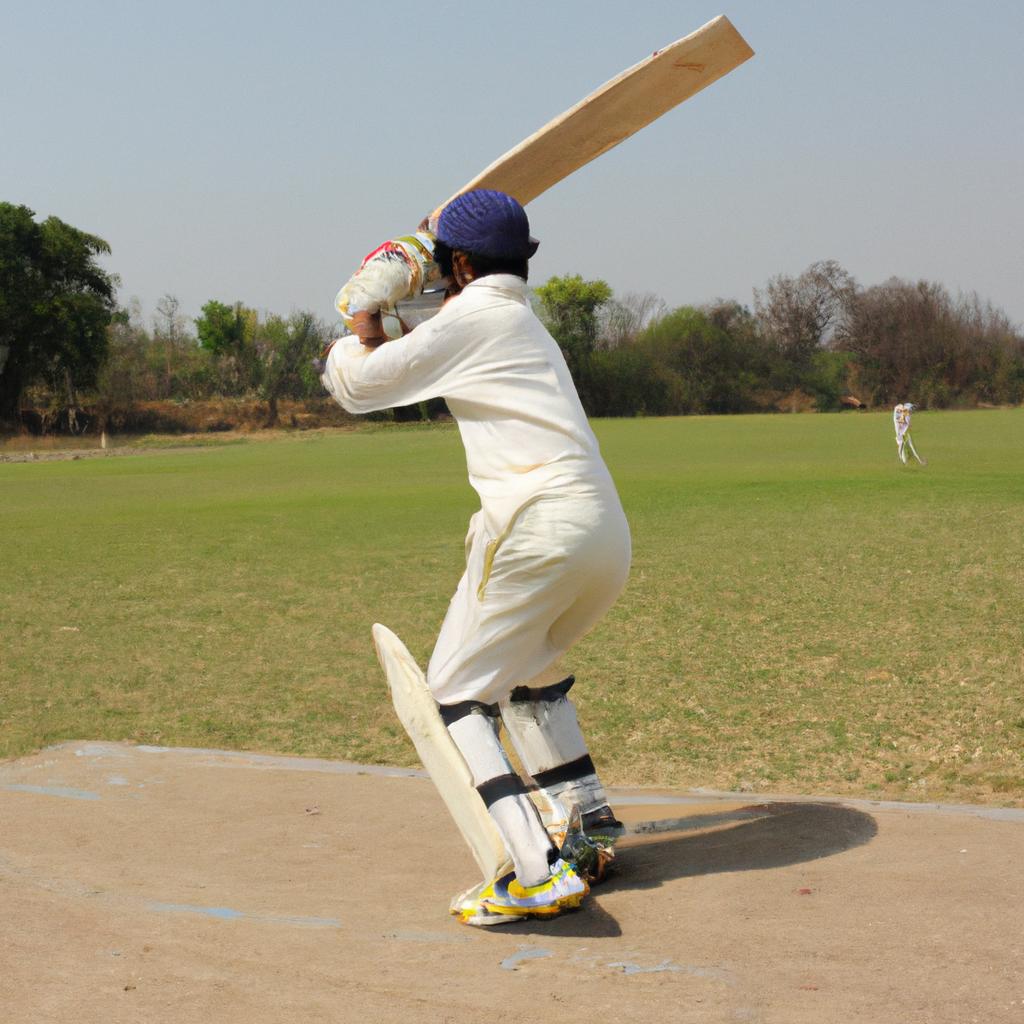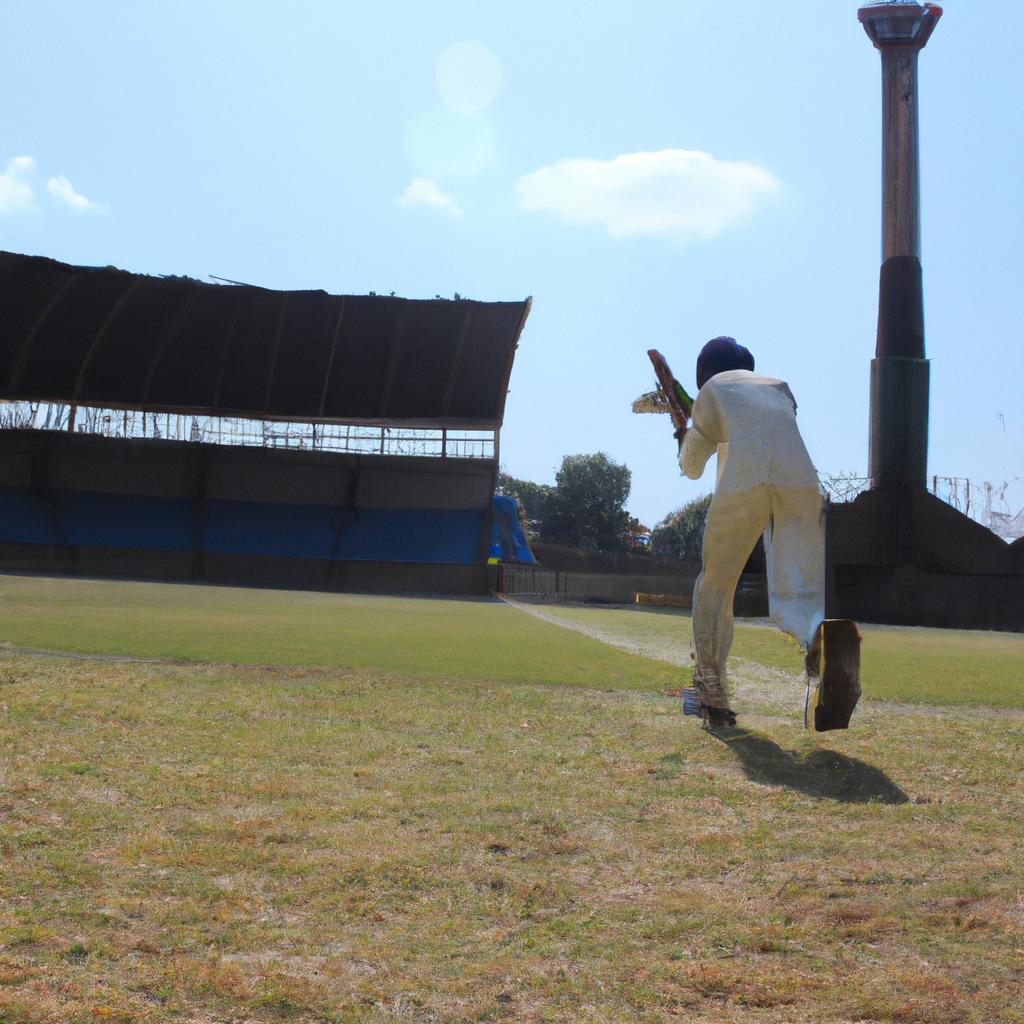Cricket, a sport known for its strategic gameplay and rich history, has captivated audiences around the world. From its origins in 16th-century England to becoming one of the most popular sports globally, cricket has evolved into a complex game governed by a set of rules and regulations that ensure fair play. For instance, imagine a scenario where two teams are competing in an intense match. The batsman hits a powerful shot towards the boundary line, but before it can cross over, a fielder catches the ball mid-air. However, confusion arises as both teams claim different outcomes – one arguing for a dismissal while the other advocating for a boundary. In such situations, understanding the intricacies of cricket’s rules becomes crucial to determine the correct outcome.
In order to maintain fairness and clarity during matches, cricket has established a comprehensive set of rules and regulations that outline every aspect of gameplay. These rules govern various aspects such as player conduct, equipment specifications, scoring methods, and decision-making processes. To illustrate further, consider another hypothetical situation: A bowler delivers a fast-paced delivery that strikes the batsman on his pads. As players from both teams appeal passionately for an LBW (leg before wicket) decision from the umpire, it is essential to understand the specific criteria for an LBW decision in cricket. According to the rules, an umpire can give an LBW decision if three conditions are met:
- The ball must pitch (bounce) in line with the stumps.
- The ball must hit the batsman’s pads in line with the stumps.
- The ball must be going on to hit the stumps, provided it is not impeded by any other factor such as a bat or gloves.
If all these conditions are satisfied, then the batsman is considered out and dismissed via an LBW decision. However, if any of these conditions are not met, the batsman will be declared not out.
It is worth noting that LBW decisions can sometimes be complex and subjective, requiring umpires to use their judgment based on their interpretation of these rules. Additionally, technology like Hawk-Eye and UltraEdge may also be used to assist umpires in making accurate decisions.
In summary, understanding the specific rules surrounding LBW decisions is crucial in determining whether a batsman should be given out or not when struck on their pads by a bowler’s delivery in cricket.
Objective of the Game
Cricket, a popular sport played worldwide, has its roots in England and is known for its unique rules and regulations. The objective of the game is to score more runs than the opposing team while also dismissing their players. To achieve this objective, teams must employ various strategies and tactics throughout the match.
One example that highlights the objective of cricket can be seen in a hypothetical scenario: Team A is batting first and aims to set a high total for Team B to chase. They strategically select their best batsmen to face the opponents’ bowlers, aiming to accumulate as many runs as possible within a limited number of overs or balls.
To better understand how teams work towards achieving their objectives in cricket, here are some important aspects:
- Collaborative Effort: Cricket is a team sport where both batting and fielding sides work collectively toward their respective goals.
- Strategic Gameplay: Teams devise strategies based on factors such as pitch conditions, weather, strengths and weaknesses of players, and knowledge about the opposition’s playing style.
- Skillful Execution: Players need to demonstrate precise hand-eye coordination, timing, technique, and athleticism to excel in different aspects of the game.
- Mental Resilience: Cricket requires mental strength as players must make quick decisions under pressure while maintaining focus throughout matches that can span multiple days.
In addition to these elements, understanding specific rules governing gameplay is crucial. This includes regulations related to scoring runs through hitting boundaries or running between wickets and methods employed by fielders to dismiss batsmen. In-depth knowledge about these rules enhances player performance and contributes significantly towards achieving desired outcomes during the game.
Transitioning into the subsequent section about “Playing Equipment,” it becomes evident that mastering cricket’s objective necessitates not only strategic thinking but also appropriate tools. The right equipment plays an integral role in enabling players to execute their skills effectively on the field.
Please let me know if there’s anything else I can assist you with.
Playing Equipment
Objective of the Game:
In cricket, the objective of the game is for one team to score more runs than the opposing team. This is achieved by batting and scoring runs while preventing the other team from taking wickets or restricting their scoring opportunities.
For example, let’s consider a hypothetical match between Team A and Team B. Team A is batting first, aiming to set a high target for Team B to chase. To achieve this, their objective would be to accumulate as many runs as possible within the allotted overs while minimizing wicket losses.
To understand how teams work towards achieving this objective in cricket, it is important to grasp some key principles:
- Batting: The batting team aims to score runs by hitting the ball delivered by the bowler into open spaces on the field and running between two sets of wooden stumps called “wickets.” Each completed run adds to their total score.
- Bowling: The bowling team tries to dismiss batsmen by getting them out through various means such as catching them out, hitting their wickets (bowled), or trapping them leg before wicket (LBW). They also aim to restrict scoring opportunities by delivering accurate and challenging deliveries.
- Fielding: The fielding team plays an integral role in supporting the bowlers by stopping boundaries and attempting catches when batsmen hit balls in their direction.
- Strategy: Both teams employ strategic tactics like placing fielders strategically around the ground based on previous observations about opponents’ strengths and weaknesses.
- Cricket requires skillful coordination among players, creating a sense of unity within teams.
- Every delivery brings excitement and anticipation as both teams strive for dominance on each play.
- Spectators experience joy with every boundary scored or wicket taken against all odds.
- Moments of tension arise during close finishes where victory hangs in balance until the last ball.
| Skill | Description | Importance |
|---|---|---|
| Batting | Scoring runs for the team by hitting the ball | High |
| Bowling | Dismissing batsmen and restricting scoring | High |
| Fielding | Stopping boundaries, catches, and supporting bowlers | Medium |
| Strategy | Planning tactics to outsmart opponents | Medium |
In summary, cricket’s objective is to score more runs than the opposing team while preventing them from doing so. This involves strategic batting, bowling, fielding, and teamwork. The game brings forth a range of emotions as teams compete passionately on every delivery. Next, we will explore the crucial aspects of the field and pitch in cricket.
[Transition sentence into “Field and Pitch” section]: Understanding the objective of cricket lays the foundation for comprehending how players utilize the unique characteristics of the field and pitch to their advantage.
Field and Pitch
Section H2: Field and Pitch
When it comes to the game of cricket, the field and pitch play a crucial role in determining the outcome of matches. The size and condition of the playing area can greatly influence the strategies employed by both batting and bowling teams. To illustrate this point, let’s consider an example scenario where a team is trying to defend their total on a challenging pitch.
One key aspect of the field is its dimensions. A cricket field typically has a circular or oval shape, with varying sizes depending on factors such as international or domestic standards. For instance, in international matches governed by the International Cricket Council (ICC), the diameter of the playing area should be between 450 feet (137 meters) and 500 feet (150 meters). However, these measurements may differ for different formats of the game, like Test matches or limited-overs cricket.
The condition of the pitch also holds significant importance. It refers to the strip of land at the center of the field where most of the action takes place. The quality and characteristics of a pitch can vary based on factors like weather conditions, soil composition, maintenance techniques, etc. In our hypothetical case study, imagine a situation where heavy rainfall occurred before a match causing dampness in one section of the pitch while leaving another part dry. This would make batting more challenging on one end compared to the other, adding an extra layer of complexity for teams.
Understanding these aspects helps players strategize accordingly during matches. Here are some notable points regarding fields and pitches:
- Ground Conditions: Pitches can exhibit different behaviors such as being spin-friendly or favoring fast bowlers.
- Outfield: The grass covering outside the pitch influences ball speed when it reaches boundaries.
- Boundary Ropes: These demarcate sixes (when hit over them) from fours (when stopped inside).
- Field Settings: Teams position their fielders strategically to maximize chances of taking wickets or restricting runs.
To grasp the significance of these factors, consider a table outlining the impact different pitch conditions can have on a team’s strategy:
| Pitch Condition | Strategy |
|---|---|
| Dry | Batting team may aim for higher scores. |
| Damp | Bowling team may prioritize swing or seam movement. |
| Grass-covered | Pace bowlers are likely to exploit the extra bounce. |
| Worn-out | Spinners might find more turn and grip on such pitches |
As teams adapt their tactics based on field dimensions, pitch behavior, outfield conditions, boundary ropes, and various other elements that contribute to the playing area, it becomes evident how crucial this aspect is in cricket matches. The next section will delve into another critical element: the scoring system used in cricket.
Transitioning seamlessly from discussing fields and pitches, let us now explore the intricate world of cricket’s scoring system.
Scoring System
After understanding the basic layout of a cricket field, it is important to delve into the specifics of its key elements. One such element is the pitch, which plays an essential role in determining the outcome of a match. The pitch refers to the central rectangular area where all the action takes place. It measures approximately 22 yards (20.12 meters) in length and 10 feet (3.05 meters) in width.
To provide better clarity on how crucial the pitch is, let’s consider a hypothetical scenario: imagine two teams facing each other in a high-stakes international cricket match. The visiting team has been struggling to score runs due to tough bowling conditions on a slow and low-pitched surface. On the other hand, the home team, with their strong batting lineup, capitalizes on this advantage by posting an imposing total that proves insurmountable for their opponents.
The condition of the pitch greatly influences both bowlers and batsmen throughout a game. Here are some factors that come into play:
- Type of Pitch: Different types of pitches exist depending on various factors such as weather conditions, soil composition, preparation methods employed by ground staff, etc.
- Bounce: This factor refers to how high or low the ball bounces off the pitch after being delivered by a bowler. Bounce can vary significantly from one type of pitch to another.
- Turn: Turn describes lateral movement experienced by spin bowlers when releasing deliveries onto certain pitches, causing variations in flight and trajectory.
- Wear and Tear: As matches progress over several days or innings accumulate during multi-day games, pitches tend to deteriorate due to footmarks created by players’ movements or general wear caused by repeated impact between ball and surface.
Considering these aspects highlights just how critical it is for teams to adapt their strategies according to different pitch conditions. Understanding these nuances can give them an edge over their opponents and significantly impact the outcome of a cricket match.
Moving forward, we will explore the intricacies of scoring in cricket. By comprehending the various methods through which runs are accumulated, one can gain a comprehensive understanding of this captivating sport’s scoring system.
Now let us shift our focus from the field and pitch to delve deeper into the world of scoring in cricket.
Bowling and Batting
Section H2: Scoring System
Having discussed the fundamental aspects of cricket’s scoring system, we now turn our attention to the crucial elements of bowling and batting. Understanding these two components is integral for players to excel in this sport.
Bowling:
In cricket, a bowler aims to dismiss the batsman by delivering the ball towards the wicket on the opposite end. The primary objective is to take wickets while restricting runs scored by the opposing team. To achieve this, bowlers employ various techniques such as swing, spin, and pace variations to deceive or challenge batsmen effectively. For instance, consider a hypothetical scenario where a fast-paced delivery swings unexpectedly, causing the batter to misjudge it and be caught behind by the wicketkeeper. This exemplifies how skillful bowling can lead to successful outcomes.
Batting:
On the other hand, batting involves defending one’s wicket against incoming deliveries while simultaneously accumulating runs through strategic shots played within certain areas of play. Batsmen must focus on timing, technique, footwork, and shot selection in order to score runs consistently. A proficient batsman possesses an understanding of pitch conditions and adjusts their gameplay accordingly. For example, imagine a real-life scenario where a batsman adeptly uses his footwork to step out of his crease and hit a well-timed lofted shot over mid-on for six runs. It demonstrates how intelligent batting can result in substantial gains for the individual player as well as their team.
Key factors that contribute to success in bowling and batting are:
- Skillful execution
- Quick decision-making abilities under pressure
- Mental resilience amidst challenging situations
- Effective communication between teammates
Furthermore, examining these key attributes will help aspiring cricketers gain insights into what it takes to excel in both bowling and batting roles.
To further enhance our understanding of these concepts, let’s look at a table that summarizes the main responsibilities and objectives of bowlers and batsmen:
| Bowlers | Batsmen | |
|---|---|---|
| Responsibilities | – Dismiss opposing team’s batters | – Score runs for the team |
| Objectives | – Take wickets | – Safeguard own wicket |
| – Restrict opponent’s run score | – Accumulate runs through shots |
As we conclude our discussion on bowling and batting, it is important to recognize that cricket involves more than just players’ skills. The next section will delve into the role of umpires and officials in maintaining fairness throughout matches. Understanding their crucial presence enhances our comprehension of this captivating sport.
Umpires and Officials
From the intricacies of bowling and batting, we now move on to understanding the role of umpires and officials in the game of cricket. Let’s delve into their responsibilities, decision-making process, and how they contribute to maintaining fairness and integrity in this sport.
Imagine a scenario where a batsman is given out caught behind by the fielding team. The umpire raises his finger signaling that the batsman is dismissed. This decision may seem straightforward, but it involves careful analysis and judgment from the umpire. Umpires are responsible for making decisions on various aspects of the game, including run-outs, LBWs (leg before wicket), stumpings, and catches. Their primary objective is to ensure fair play and enforce the laws of cricket without bias or favoritism.
To aid them in their decision-making process, umpires have access to technology such as Hawk-Eye, Snickometer, and Hot Spot. These tools assist in determining whether a ball hit the bat or pad first during an LBW appeal or if there was any contact between bat and ball during a catch. However, despite these technological advancements, certain decisions still heavily rely on umpire intuition due to factors like inconclusive evidence or limitations of technology.
Umpiring decisions can be met with mixed emotions from players and spectators alike. Here are some key points highlighting both challenges faced by officials and emotional responses tied to their judgments:
- Umpiring errors: Despite their best efforts, umpires may make mistakes which could potentially impact the outcome of a match.
- Controversial decisions: Occasionally, contentious decisions arise that spark debates among experts and fans about perceived biases or unfairness.
- Fairness: Umpires’ impartiality ensures equal treatment for all teams involved in a match.
- Respect for authority: Players must respect umpires’ decisions even when they disagree with them.
Emotions often run high during cricket matches due to close calls, tense situations, and the stakes involved. Umpires play a crucial role in maintaining order on the field, ensuring fair competition, and upholding the spirit of the game.
| Decision | Emotional Response |
|---|---|
| Correct decision favoring one’s team | Relief and elation |
| Incorrect decision against one’s team | Frustration and disappointment |
| A tight call that goes in favor of either team | Nervousness and anticipation |
| An umpiring error leading to an unjust outcome | Anger and dissatisfaction |
In conclusion, umpires and officials hold immense responsibility in cricket. They make critical decisions that impact matches while striving for fairness within the framework of this beloved sport. Though they may occasionally face criticism or controversy surrounding their judgments, their presence ensures smooth gameplay by enforcing rules impartially.












